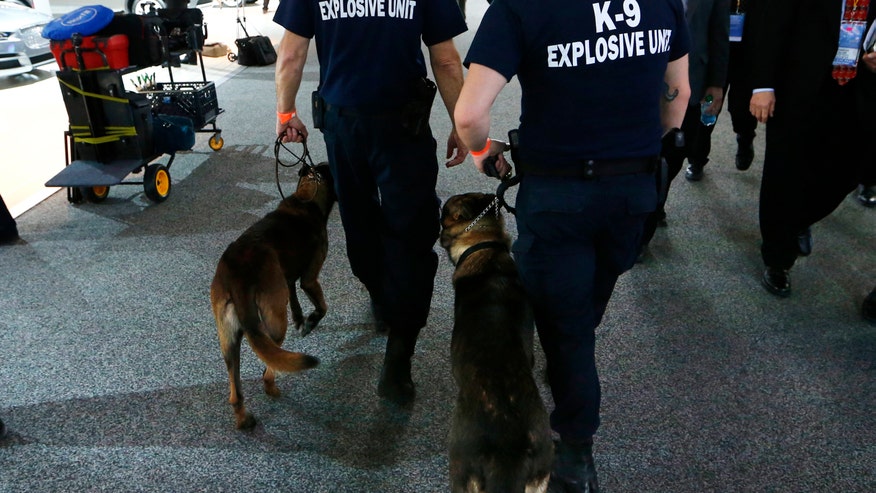
File photo. Two police officers guide bomb-sniffing dogs past exhibits during the second press day of the North American International Auto Show in Detroit, Michigan, January 13, 2015. (REUTERS/Mark Blinch)
Bomb dogs regularly risk their lives to save our troops and law enforcement – and now next generation technology will help make these dog heroes safer.
New tech out of Department of Homeland Security Science & Technology
Directorate Explosive’s Division together with the Johns Hopkins Applied Physics Lab allows dogs that are training to serve the United States, to do so a whole lot safer, according to a Department of Homeland Security press release.
Explosive detection canines (EDCs) are often called bomb dogs. Training programs for these dogs tends to involve the dogs learning to detect explosives by training with real explosive materials.
Training with explosive materials is not easy and by definition poses risks, particularly the new homemade bomb materials that are surfacing as threats. It also limits flexibility with training environments since placing real explosives in a real crowded airport for training poses inherent risks.
This new tech means that rather than working with real explosives, this new canine training aid accurately matches the scent of explosives — but doesn’t explode and reduces risk to both the canines and instructors.
Why are bomb dogs important to Homeland Security?
Bomb dogs are a key line of defense when it comes to protecting the homeland.
Dogs are naturally adept at identifying scents. Their noses are a million times more sensitive than a human’s nose and they can be trained to detect lots of different specific scents even drugs and explosives.
Training helps dogs learn to identify smells that indicate there is a hidden threat like explosives. Dogs also learn how to find the scents of dangerous threats. They learn to sniff along the seams of a suitcase, say, or underneath a pallet where the vapors that are heavier than air settle.
The dogs are trained to search for threats and then alert their handler to its presence by pawing or barking. In the event of something dangerous, many dogs are trained to sit or lie quietly.
Bomb dogs provide lots of advantages. They are highly mobile and can instantly identify the source of an explosive odor.
The demand for dogs to deploy in homeland security missions continues to increase. The escalating demand runs up against shortages in the right type of puppies with the right noses as well as intelligence and temperament. Another challenge has been equipping training facilities with non-hazardous versions of homemade explosives with which to train.
The TSA National Explosives Detection Canine Teams work to protect all sorts of transportation environments from aviation and mass transit through to cargo.
Hundreds of teams deploy around the country to address threats. Teams can be deployed anywhere in the transportation system in minutes.
Together with government agencies like the Department of State and the Secret Service, bomb dogs deploy with their handlers to keep motorcades and political arenas safe for US high profile political figures as well as figures from around the world.
In addition to transportation and high profile figures, teams deploy to keep all sorts of areas in the US safe like sports arenas, offices and schools.
Lots of advances have been made with canine detection over the past decade. Detection dogs deploying off the leash is one of these key advances. The approach had been a handler moving a dog on a leash with six feet between the two and deploying dogs off the leash can greatly accelerate locating the threat.
The tech
Lots of companies have been trying to create pseudo-explosives, but often when used in training the dogs could not reliably identify real explosives. Many trainers share the view that imitation training aids could not replace the real thing in training. Real explosives were necessary for the best training, but also involved the risk of real explosives.
The advanced training aid underwent field-testing within federal, state, and local canine detection teams. The dogs responded to the training aid just like they would react to real explosive material.
This technology now provides a matching scent with the huge advantage that it is innocuous. Their training aid does not pose a threat to the trainers, the canines or the environment.
“It doesn’t go boom if you drop it, hit it or light it on fire,” Canine Program Manager Don Roberts said in the release. “That allows teams to take the training from the very controlled environment we currently have to train in for safety reasons and put it in a real-world scenario — for example putting the odor in a cinderblock and seeing if the dog can find it. We can put this new training aid in car wheel wells, airports etc., without fear that they’ll explode.”
There are a number of other advantages to these new training aids as well. The aids can be thrown away after being used. They last for more than eight hours and the scent can be dissolved in water.
Explosive training materials are far more labor intensive requiring special handling, transport and had to be stored in secure bunkers. These new training aids are long lasting and can be stored up to two years.
After a number of trials, DHS has been transferring the technology to the Transportation Security Administration. The primary customer for the aid will be the TSA.
But S&T (Science and Technology) has kept state and local detection dog teams in mind developing this aid. They’ve made sure it is affordable and practical for these teams that don’t have access to regular training support like the TSA.
A second scent is due to be released later this year.
Ballet dancer turned defense specialist Allison Barrie has traveled around the world covering the military, terrorism, weapons advancements and life on the front line. You can reach her at wargames@foxnews.com or follow her on Twitter @Allison_Barrie.

